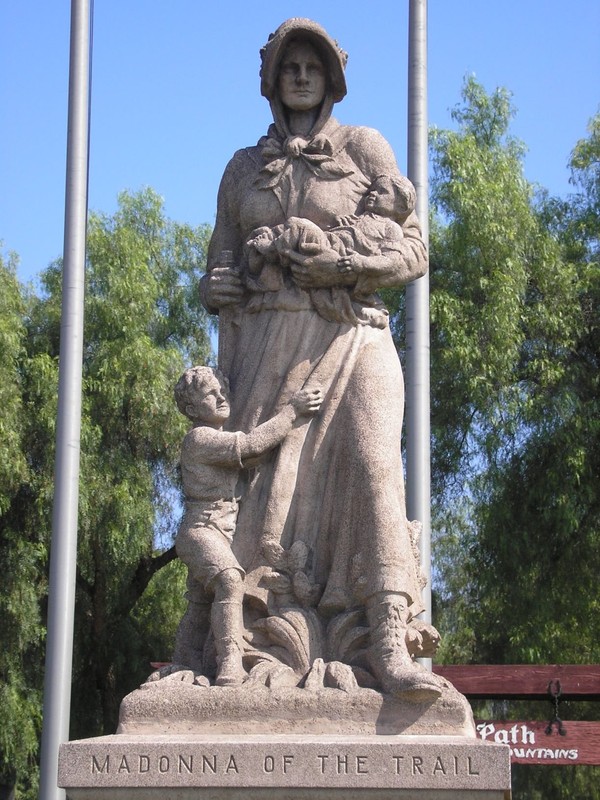Madonna of the Trail (Upland, CA)
Introduction
Text-to-speech Audio
Images
Madonna of the Trail, Upland, California. Photo by Cynthia Prescott.

Backstory and Context
Text-to-speech Audio
The project began when a group of Missouri women decided to mark the Santa Fe Trail route. In 1911 the National Society, Daughters of the American Revolution (DAR) set out to mark the “Old Trails Road” stretching from Maryland to California. DAR women worked with the National Old Trails Road Association to mark the old Santa Fe Trail and other western migration routes. In keeping with gender norms of that period, the men of the National Old Trails Road Association “handle[d] the basic and practical side of the question,” while the DAR’s national committee “handle[d] the historic and sentimental side.”1 In 1927, Association president (and future U.S. President) Harry S. Truman and President Coolidge received congressional approval for the creation of a national memorial highway stretching from the Atlantic to the Pacific.
Initial plans called for painted mileage markers throughout the route. Inspired by Alice Cooper’s 1905 Sacajawea statue for Portland, Oregon, DAR women abandoned mileage markers in favor of 10-foot-tall pioneer mother statues. Twelve identical statues would be placed in the 12 states through which the “Old Trails Road” passed.
National DAR Commission chairperson Arlene B. Nichols Moss and her artist son worked with architectural sculptor August Leimbach to design the DAR statues. Sculptor August Leimbach envisioned a scene in which she is looking for her husband whom she believes to be in danger.
Each Madonna of the Trail strides purposely westward, dressed in a simple homespun prairie-style gown and wide-brimmed sunbonnet. Like other Pioneer Mother statues erected during the late 1920s, the 12 DAR statues balanced strong, active roles for women with softer maternal symbolism.
The statues were cast from algonite (a form of cast stone produced from a mixture of crushed marble, Missouri granite, stone, cement and lead ore) at the cost of $1,000 per statue. The statues were placed along key white migration routes, such as the early-19th-century National Road (later U.S. Route 40) and Santa Fe Trail (later the infamous Route 66). But the precise location of the monument within each state was selected based on both the site’s historical significance and the influence of local DAR and National Old Trails Association chapters.
The Ontario and Upland DAR chapters dedicated California's Madonna of the Trail on February 1, 1929. Eighty-one-year-old Carolyn Emily Cook, who migrated overland to California as a young child, unveiled the statue. One hundred carrier pigeons were released as Clark removed the covering.
A parade celebrating the dedication told the history of California over more than a century of Euro-American settlement. It emphasized progress from a Native American past to white-dominated present.
Over time, most Americans forgot about the Madonna of the Trail statues, including Upland's. But the more diverse suburban Upland, California’s population became, the stronger that community’s investment grew in their Pioneer Mother Movement-era statue.
Established in the 1880s, postwar interstate highway construction transformed agrarian Upland into a bedroom community for burgeoning Ontario. Whites, African Americans and Latinos escaping nearby Los Angeles’ rapid growth and urban unrest converged with immigration from Latin America and Asia. By the early 21st century, Upland’s population--like that of Southern California overall--grew quite diverse. But Upland remained much more white than neighboring Ontario, which was 69.0% Hispanic or Latino, and only 18.2% non-Hispanic white.2
As Anglo-Americans lost their majority status, Uplanders embraced their Madonna of the Trail as an emblem of white middle-class cultural norms. One Upland resident proclaimed in 2011 that the Madonna was crying because she--along with her community--had recently discovered that the size of City Manager Robb Quincey’s annual salary. Similarly, that same year a local columnist likened a coming Shakespeare production to seeing “a full frontal nude Madonna of the Trail in the middle of Euclid Avenue.”3 Upland's Madonna of the Trail thus enjoys renewed relevance nearly a century after its erection.
Cite This Entry
Prescott, Cynthia. "Madonna of the Trail (Upland, CA)." Clio: Your Guide to History. July 30, 2019. Accessed April 18, 2025. https://theclio.com/tour/930/12
Sources
2 Website Services & Coordination Staff. “US Census Bureau 2010 Census Interactive Population Map: Ontario, California.” Accessed May 30, 2017, https://www.census.gov/2010census/popmap/ipmtext.php?fl=06:0653896.
3 “John Weeks: To Be or Not to Be Squeamish,” The Sun, May 12, 2011.
David Allen, “In Upland, the Hits Just Keep on Coming,” Inland Valley Daily Bulletin, April 12, 2011.
Daughters of the American Revolution. Twenty-Second Report of the National Society of the Daughters of the American Revolution: March 1, 1918, to March 1, 1919. U.S. Government Printing Office, 1921.
Bauer, Fern Ioula. The Historic Treasure Chest of the Madonna of the Trail, J. McEnaney Printing; Springfield, Ohio, 1984.
Medlicott, Carol, and Michael Heffernan. “‘Autograph of a Nation’: The Daughters of the American Revolution and the National Old Trails Road, 1910–1927.” National Identities 6, no. 3 (2004): 233–260.
Prescott, Cynthia Culver. Pioneer Mother Monuments: Constructing Cultural Memory. University of Oklahoma Press, 2019.

